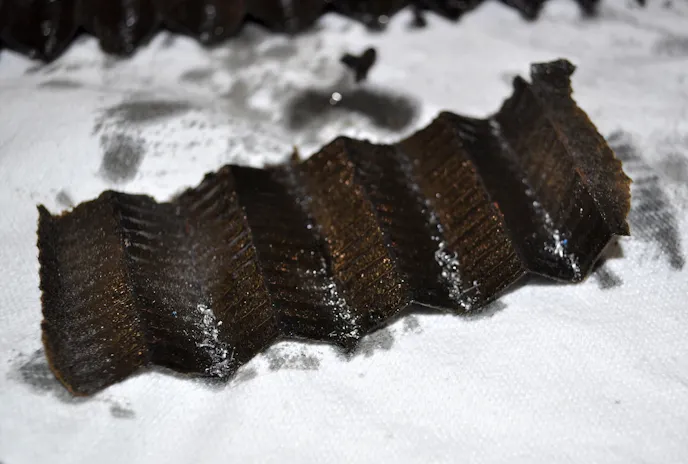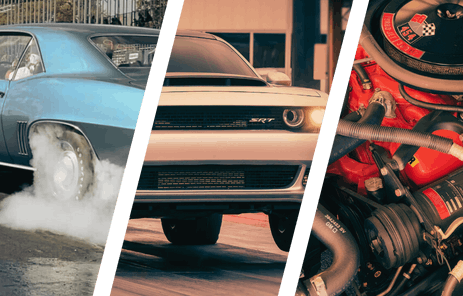Cutting open your filter can reveal a lot about your engine
Words And Photos: Cindy Bullion
If the lifeblood of an engine is its oil, then it stands to reason an oil filter is the liver. Its purpose is to clean that “blood” before it cycles again through the “body,” providing nutrients, regulating temperature, and picking up any unhealthy toxins along the way. Thus, maintaining a healthy oil filter is crucial to the health of the engine.
Certified Lubrication Specialist Lake Speed Jr. says just as doctors can look at a person’s liver to see if something unhealthy is happening elsewhere in the body, you can inspect the oil filter on your engine to detect problems deeper within.

“Checking the filter is an easy way to check the health of your engine and oiling system,” he says. “If your filter is filled with metal shavings, then you have a problem! If the filter is plugged with sludge, then you have a different problem.”
Metal flakes or shavings in an oil filter, or oil pan, are an indication of metal meeting metal somewhere in the engine. This could be due to improper oiling, like not using the correct viscosity for your application or not using an oil with the proper additives for the design and use of your engine. Also, not having enough volume of oil can lead to inadequate pressure for oil to reach and lubricate all components.
The presence of sludge, which appears as a tar-like substance, is a tell-tale sign the oil has oxidized. This can occur when the engine reaches a high temperature or oil is not changed frequently enough. Severe driving conditions that produce increased levels of contaminants — such as gases, water vapor, fuel — also contribute to sludge that bakes onto engine components and clogs passageways, just as cholesterol in the body collects in arteries and restricts blood flow. Additional effects of sludge include reduced fuel economy, strain on the cooling system, and potential engine failure.
According to Speed, it is not a good idea to inspect your engine’s oil filter during every oil change. For engine builders, an oil filter inspection should also occur after the break-in cycle and, if the engine is for racing, again after a few runs on the track, then at regular oil change intervals.
Using an oil filter cutter cuts down on mess and potential injury — that metal casing edge can be sharp. Just a few turns is all it takes to get inside and inspect for metal flakes or sludge.
Remember, you are bound to find some contaminants during any oil filter inspection; the filter wouldn’t be doing its job otherwise. Sludge and metal shavings should always cause a moment of pause, though. The purpose of inspecting the filter is, after all, to diagnose any problems before they get out of hand.
And just what is the process for inspecting that filter? Let us walk you through.
We used Powerhouse Products’ Oil Filter Cutter (PN# 351646) to cut open our filter. Placing the filter, pre-drained and opening up, in a vise helps on the safety and cleanliness fronts. Once you have clamped the cutter onto filter, spin slowly and evenly until it breaks through the metal casing. You may need to tighten the cutter after a spin or two.
The top of the filter should be easily removable after cutting, and it can be tossed in the trash by simply loosening the cutter’s clamp — no messy hands.
You can now remove the seals, followed by the filter media. Let the media drain for 10 or more seconds before putting it aside to take a look at the little bit of oil remaining in the canister.
You may be able to see sludge or contaminants — like the metal shavings and gasket sealer here — that have settled to the bot-tom of the cut open canister.
Since there were obvious signs of contaminants in the canister and from a quick check of the filter media pleats, we used a box cutter to separate the “guts” for closer inspection.
The filter media can now be unfolded like an accordion, exposing contaminants hiding deep in the pleats.
Once unfolded, it’s easy to see contaminants. A small amount of metal shavings are normal in a new engine, but beyond the break-in period, shavings may indicate component failure. In this case, you’d probably want to start looking in the engine for a problem.
A magnet is a great tool to help you determine if metal shavings in the filter are steel and, then, where to go to in the engine for further work. Aluminum or titanium shavings will not stick to the magnet.
Source
Driven Racing Oil
drivenracingoil.com
You might also like
PRI 2025: Katech Fills Oil Pump Void For Dry Sump LS3, LS7
The TrackFlow pump is engineered to address the critical oil control demands of track-driven and high-performance street cars


